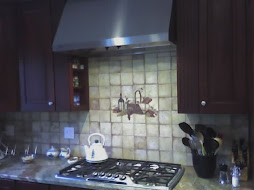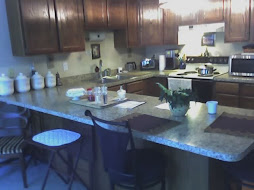Today's design trends call for a mixture of flooring choices in our homes. This inevitably leads to tricky transitions between ceramic tile and other flooring materials. We began this discussion some weeks ago with this advice article:
How to install ceramic floor tiles next to wood flooring
Readers were quick to comment, probably because there is always more than one way to address these unlike-materials transitions.Floor tiles guy said... Great article, it would be great to see a follow up article on advice with what to do when you are tiling from your kitchen up against a carpeted surface. Thanks
Robert said... Floor tiles are commonly used in home renovations today. Your post discussed the two possible scenarios when tiles are installed beside hardwood flooring. Among the two cases, the one with uneven levels is problematic. I agree with Floor tile guy that a follow up about repairs in those instances would be very useful to your readers.
In our case, spared us of such problems when we renovated our house. We have a maple hardwood flooring for the living area and used ceramic (Brandon) tiles for the kitchen. The floor looked neatly done because we had ample time to plan and discuss details like sub-floor foundation. In any case, a renovator must be very keen on details like measurements of the sub-floor and thickness of the tile to achieve a fairly even floor for his house.
"Fairly even" is the key to making good tile transitions. Robert is exactly right.
The minimum recommended thickness for ceramic tile installation is about 5/8" -- and that's using a minimal 1/4" tile backer-board or the newer Ditra-brand substrates from Schluter. Fortunately, this thickness works well with most installed carpeting. Typically, carpet plus padding adds up to about 5/8" -- although the type of carpet and the thickness of the selected pad can vary this measurement.
When tile and carpet are of nearly identical heights, you can use marble thresholds (bathroom) or simple square-finish tile edges. In both cases the carpet is stretched and tucked using the standard tackless strip. If the carpet is somewhat higher than tile, Schluter offers stepped edges to 'clamp down' thick carpeting.
Many times, however, porcelain tile installed over a thicker substrate like 1/2" Durock from USG will add up to a floor that's nearly one inch thick, not including the original house subfloor. That extra thickness puts the finish tile substantially higher than the nearby carpet. In this case, you have a couple of good choices:
- Use a "Hollywood" style marble threshold, which has a long bevel on one side to lead back down to carpet level. This works fine in a Master Bath off a carpeted bedroom, for instance.
- In high visibility common areas, a better choice would be a ramped metal Schluter edge (as mentioned in the original article about transitioning to hardwood floors). You could even consider a softer plastic-edge for a more subtle effect.
Or, attacking the problem from the opposite direction, make the carpet thicker! It's easy and relatively inexpensive to add 1/4" to carpet thickness, merely by first installing basic luan underlayment before carpet is installed.
With tile transitions, as with so many things in life, the best answers usually come down to proper planning and preparation. Taking a little extra time to look ahead before you begin the installation -- and also to consider using specialty products designed for tricky situations -- can mean the difference between mediocre results and professional finishes.
copyright 2010 - all rights reserved * reprints upon request
_______________________________________________
What tile problems have you encountered? Your ideas for future posts and pictures are always welcome. For more tile information, see my DIY Tile Zone, hosted on Helium.
See the earlier article as it appears on Helium.com
+edit.jpg)





















.jpg)
